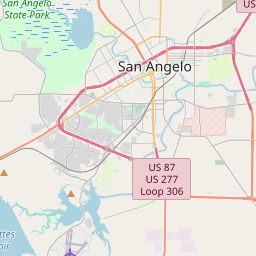First Baptist Church of San Angelo
Historical marker location:






The first Baptist missionary efforts in this area began in 1881 with Dr. Owen C. Pope and the Rev. L. R. Millican, who became noted for their work on the Texas frontier. Although it is not known exactly when this congregation was organized, a fellowship known as the Baptist Church of Christ at San Angelo began in 1883 under the leadership of the Rev. Z. M. Wells. In 1886, L. R. Millican returned to San Angelo as pastor, and a state charter granted the same year changed the fellowship's name from the Baptist Church of Christ to First Baptist Church of San Angelo. Membership increased during the early years of the church, despite an 1886 drought, an 1887 cyclone, and the abandonment of Fort Concho by the United States Army in 1889. The Sunday School, which had about 50 members by 1886, contributed much to this growth by providing education and training for the members.
Throughout its history, First Baptist Church of San Angelo has supported and provided leadership to missionary efforts, particularly in Mexico and Brazil. Its members have organized several other Baptist churches in the area. Over the years, the congregation's role in the community has been one of significant service and leadership. (1984)
As one of the most visible programs of the Texas Historical Commission (THC), historical markers commemorate diverse topics in Texas history, including: the history and architecture of houses, commercial and public buildings, religious congregations, and military sites; events that changed the course of local and state history; and individuals who have made lasting contributions to the state, community organizations, and businesses.
The state flower of Texas is the bluebonnet. The flower blooms in the spring and is a common sight along the highways and in fields throughout the state.
In the late 1800s, the county began to attract settlers looking for opportunities in ranching and agriculture. This period saw an influx of farmers and ranchers who developed the land for cattle and sheep grazing, as well as growing crops such as cotton, corn, and wheat. The population increased significantly during this time, leading to the official organization of Tom Green County in 1874.
The county experienced rapid growth during the late 19th century, thanks to the establishment of Fort Concho and the expansion of the railroad. Fort Concho served as a primary military post protecting settlements against Native American raids and fostered economic growth by providing stability and resources to the region. Additionally, the arrival of the railroad in the 1880s further spurred economic development, making transportation of goods easier and stimulating trade.
In the early 20th century, Tom Green County faced several challenges, including droughts and the Great Depression. However, the county managed to overcome these obstacles and continued to thrive. Today, Tom Green County is known for its agriculture, oil and gas production, and as a center for healthcare and education. With a rich history that encompasses Native American heritage, frontier life, military significance, and economic growth, Tom Green County has played a vital role in the development of West Texas.
Tom Green County Timeline
This timeline provides a concise overview of the key events in the history of Tom Green County, Texas.
- 1874 - Tom Green County is organized and named after Confederate General Thomas Green.
- 1882 - The first courthouse in Tom Green County is built in the city of Ben Ficklin.
- 1884 - San Angelo becomes the county seat after a contentious election.
- 1886 - The Texas and Pacific Railway line is extended to San Angelo, boosting the city's economy.
- 1899 - San Angelo is incorporated as a city.
- 1928 - Goodfellow Air Force Base is established as a training facility during World War II.
- 1952 - Construction of the O.H. Ivie Reservoir begins on the Colorado River near San Angelo.
- 1995 - The San Angelo Museum of Fine Arts opens.
- 2002 - San Angelo experiences a devastating flood, causing significant damage to the city.
- 2015 - The San Angelo Stock Show and Rodeo celebrates its 83rd anniversary.